Alan Cathcart | February 26, 2016
 Similar to the outgoing model in looks, but you can’t judge a book by its cover.
Similar to the outgoing model in looks, but you can’t judge a book by its cover.
Triumph’s Speed Triple R is now of legal drinking age—so it’s time for some new clothes!
As it comes of age in celebrating its 21st birthday, the motorcycle that for the past couple of decades has been the marketplace reference for hooligan-bike hot-rodding, has actually grown somewhat warm and cuddly—respectable, even. For indeed, that’s what the Triumph Speed Triple, last updated back in 2011, has become by comparison with the brash copycat kids from KTM, BMW, Ducati and Aprilia, which have come along of late to try to knock off the British bike ⎯ which invented the streetfighter sector off its best-selling pedestal ⎯ via more cubes, more power and more grunt, plus racetrack-worthy electronics and chassis hardware. Oh, and even more attitude, an attribute which the best of British trendsetter adopted big time in breaking all the rules upon its creation back in the mists of time. Well, 1994, actually.
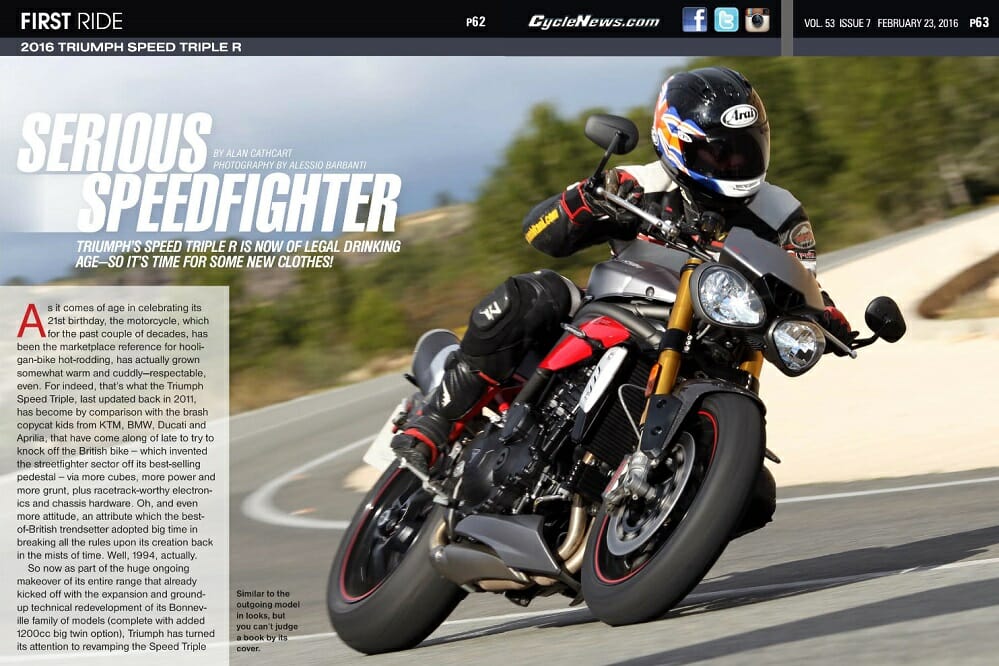
You can read the original magazine story by clicking HERE.
So now as part of the huge ongoing makeover of its entire range that already kicked off with the expansion and ground-up technical redevelopment of its Bonneville family of models (complete with added 1200cc big-twin option), Triumph has turned its attention to revamping the Speed Triple that’s made such a key contribution to the profitability of John Bloor’s company over the past two decades. However, while they’d much rather you didn’t call the result evolutionary, Triumph management has resisted both spending lots of money by completely binning everything that’s gone before and starting over again—a as they’ve essentially done with the Bonneville, albeit retaining the same overall architecture—and at the other end of the scale just splashing a few pounds sterling on merely making a few minor touch-ups to the existing model to try to wreak a little more revenue from it in the face of its recently launched rivals.
Instead, what Triumph has done is to radically upgrade the existing Speed Triple, and when you ride the new bike back to back with the current model, as I was able to do, you pretty soon realize this makeover is so transformational that it essentially amounts to creating an all-new model. That’s an impression confirmed by the morning I spent aboard a Speed Triple R chasing Triumph test rider Felipe Lopez through the great hillside roads inland from Tarragona on the sunny Spanish Mediterranean coast close to Triumph’s R&D HQ, followed by an afternoon session at the Calafat racetrack—Spain’s oldest permanent circuit, and a great track for exploring the maneuverability and rideability of any motorcycle. Add in the much sleeker, sharper styling of the new model, which thanks to positioning the front end hardware—new DRL lights, dash, handlebar—notably lower so that the fuel cap is now the highest part of the bike, definitely regains most of the in-your-face visual attitude that went missing with the 2011 restyling job. It’s a generational change that was partially triggered by the need to meet the tough new Euro 4 noise and emissions regulations. Good on the Brussels bureaucrats for stimulating this revamp!
 It’s still got that brutish stance the Speed Triple is known for; it’s just a little more refined.
It’s still got that brutish stance the Speed Triple is known for; it’s just a little more refined.
Power Play
With 140 bhp at 9500 rpm, it may sound relatively wimpish compared to the 160 bhp output delivered by the new Ducati Monster 1200, let alone the 177 bhp offered by the KTM 1290 Super Duke, and as with the Street Twin, this relatively small increase in performance numbers doubtless explains why Triumph declined to reveal the new Speed Triple engine’s figures at its EICMA Show debut. However, it’s not till you ride the two different generations of the model back to back that you fully realize what a significant difference in rideability and responsiveness this new bike has achieved—and furthermore, how much more accessible and engaging a the new Triumph is even compared to KTM’s supreme street rod, or its Ducati rival for naked bike supremacy.
“We weren’t interested in getting into a horsepower race,” says Triumph’s Stuart Wood. “Our focus was to refine the engine while delivering a little more all-round performance. The enhanced response you feel is down to improved combustion and the ride-by-wire throttle. This is a real enabler for us since it lets us control the throttle body butterfly exactly how we want it to behave. This allows you to have quite a well-tuned engine, but also to keep it refined with a really smooth torque delivery. Historically, in the past you’d have refined an engine by softening it, but we now have so much control we don’t have to throw a load of fuel down the ports to get the required response like you used to have to do.”
It’s therefore mission accomplished for Wood and his men, for aside from an even more linear power delivery on a bike, which to be fair didn’t exactly have any steps in the power curve before, the big difference on the new Speed Triple is the substantially meatier torque now on tap all the way through the rev range, and especially in midrange where there’s a better than five-percent increase between 4000 rpm and 7500 rpm. That’s where you find yourself operating most of the time in everyday use aboard a bike which is notably more involving to be on than its predecessor.
You’re aware of this from the moment you climb aboard the new Speed Triple to discover a completely different riding position, with lower, less pulled back grips to the notably flatter, chunky-looking, one-piece taper-section handlebar. This results in a slightly sportier leaned-forward stance that isn’t unduly tiring, just more engaging. The stock bar-end mirrors are practical as well as good-looking, though I did find they’d repeatedly vibrate out of position at speeds of 80 mph or more, so that needs attention. The footrests are also lower and mounted slightly further back, but the key issue is that the very comfy good-looking seat adorned with contrast stitching that’s just one of many touches that betray Triumph’s considerable attention to detail in designing the new bike, is 20mm narrower than before where it meets the rear of the all-new more streamlined looking four-gallon fuel tank. A similar trick has also been pulled on the new Bonneville range, and shorter riders including females will welcome being able to place both feet flat on the floor at stoplights as a result. The seat itself has been redesigned to incorporate more substantial foam, for a comfier mile-eating posture, and the net result is that with the 32.5-inch seat height which delivers a sense of spaciousness aboard it, you feel more a part of this dynamically vivacious motorcycle than the current model it replaces, where it seems you’re more parked on top of the bike than on this one. Yet the aluminum twin-spar chassis and tubular steel subframe are unchanged from the outgoing model, as is the cast aluminum swingarm, so it’s just the rider packaging that Triumph has focused on changing chassis-wise, with positive results.
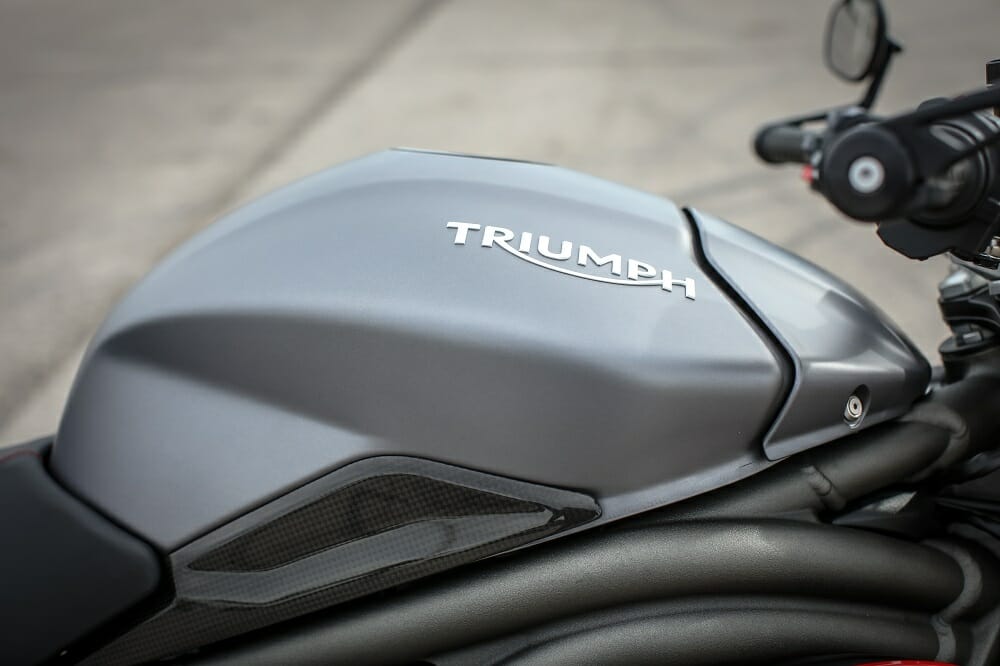 A newly designed tank is far more angular and encompassing than before.
A newly designed tank is far more angular and encompassing than before.
Calling The Cavalry
So once you’ve lit up the glorious-sounding three-cylinder engine with even 120-degree crank throws, via the clever combined kill switch and starter button, it’s evident how much more low-end torque there is on the new model, compared to the not exactly reticent outgoing one. Its noticeably greater midrange muscle from 4,000 rpm upwards is matched by an extra kick of grunt at 7,000 revs en route to the 10,000-rpm limiter. This provides more zestful acceleration low down, but not at the expense of a snatchy or unduly fierce pickup from a closed throttle in any ratio, in any riding mode, though Track obviously has a stronger pickup than Road, it’s nevertheless controllably so. This extra torque also enables you to use one gear higher in plenty of places, thus riding the curve as you might do on a twin, while cutting down on gear changing. Not that you need to, exactly, for the all-new gearbox Triumph has fitted to the bike derived from the 675R Daytona transmission is absolutely flawless, the disappointing gearshift was my major source of complaint on the outgoing model. Triumph has fixed this big time on the new one, resulting in a shift action fully up to Japanese standards that’s so good, you barely need to use the clutch at all even downshifting through the gears. However, there’s no wide-open powershifter as there should be, at least on the R-model that I did all my riding on. The extra cost over the S-type gets you a fully adjustable 43mm Öhlins NIX30 upside down fork and TTX36 twin tube rear monoshock (the S-model has Showa suspension front and rear, also fully adjustable), plus a carbon front mudguard and side panels, color-coded belly pan and a red-painted subframe for the seat, matched by red wheel pinstripes and seat stitching. There are also some billet machined aluminum parts like the handlebar clamp and risers, plus special R color schemes of white gloss or matte graphite, both with the red subframe. The S-version comes in either red or black, both with black frame and subframe, and white pinstriping on the wheels, and white seat stitching.
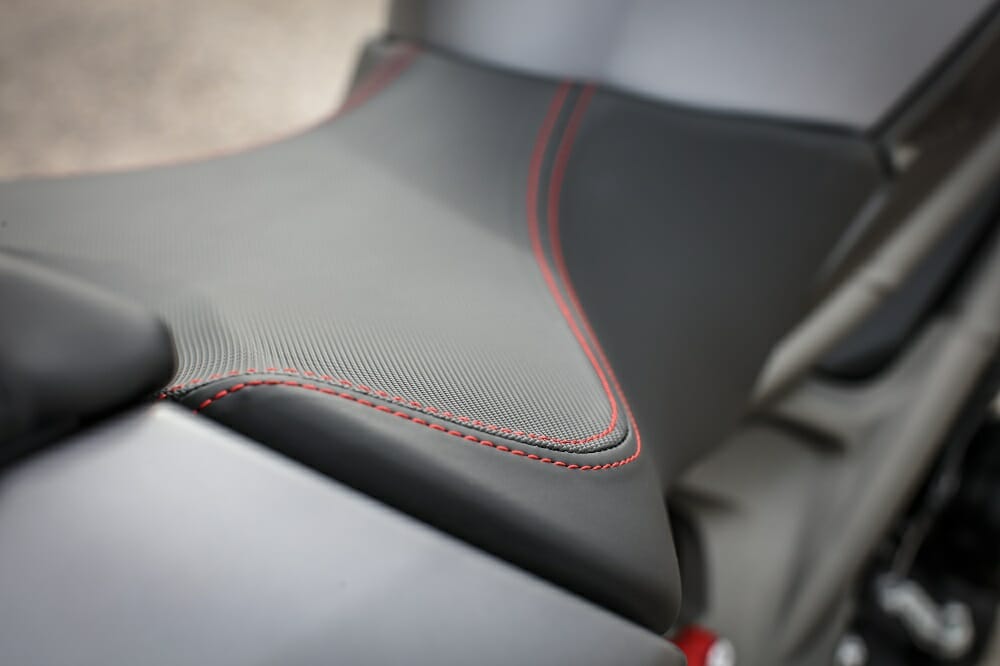 Beautiful red stitching—the attention to detail is marvelous.
Beautiful red stitching—the attention to detail is marvelous.
However, while inexplicably failing to transfer the 675R’s powershifter to the new Speed Triple along with its gearbox technology, Triumph has now adopted what it calls a “slip-assist” clutch on the new bike. This a ramp-style slipper clutch by any other name, complete with the trademark subdued click when you backshift down through the gears under heavy braking, with switchable ABS in reserve in case you exaggerate exactly how heavy. The slipper clutch setup retains enough engine braking still dialed in to help the twin radial Brembo two-pad four-pot calipers fitted to both versions of the Speed Triple stop you hard and late when you squeeze the adjustable lever, while ensuring good stability. This new version of Triumph’s streetfighter holds a line very well on the brakes, which means you can trail brake into the apex of a turn with impunity—it won’t sit up on you so that you miss the apex and head for the hedges, and the pickup when you get back on the throttle again is measured and controlled. Nice. It also holds a line well round fast 75 mph sweepers, but the main difference with the outgoing model is the way the revised riding stance makes the new one seem more responsive in the way it steers in slower, tighter turns, where it makes it easy changing direction via the good leverage from the flatter handlebar. The new Speed Triple’s 56.4-inch wheelbase, 3.59-inch trail and 22.9-degree rake are all essentially unchanged from before, in spite of which it seems definitely more agile and maneuverable when ridden back to back with its predecessor.
 This shows just how far you can crank the new Speed Triple over and not scrape anything!
This shows just how far you can crank the new Speed Triple over and not scrape anything!
Smoother, Better
But at the end of the day it’s the significant step up in engine rideability that makes the new Speed Triple so much fun to ride, especially in the absence of any vibration whatsoever from the three-cylinder motor, which is even smoother than before thanks to the revised gear drive to the single counter-rotating primary balancer at the front of the engine. To the evocative background soundtrack of its trademark intake roar and exhaust note, the triple motor’s dynamic character inspires you to ride it hard, holding second gear for mile after mile along winding country roads, flicking from side to side effortlessly through the curves without a need to shift gear to tackle anything between a slow 25 mph hairpin and a 75 mph sweeper. Plus the carryover Öhlins rear suspension apparently has a softer setup on the new Speed Triple R I was riding than the old, thus supplying not only improved ride quality via its 5.1 inches of wheel travel (versus 4.7 inches up front), but also greater compliance over rough surfaces, without detracting from its ability to lay the power down when you accelerate hard out of a turn leaned over.
Triumph has a revised version of its multi-functional LCD instrument pack on the bike, which incorporates an analogue tacho coupled with a digital speedometer, fuel gauge, trip computer, lap timer, programmable shifter lights, and setting displays for gear selected, riding modes, ABS etc. It works well and is quite easy to read, but I can’t help thinking it looks a little old-fashioned against the TFT color displays on its KTM and Ducati rivals.
The Triumph Speed Triple isn’t a bike for criss-crossing continents, and certainly not for riding very far or long two-up, even with the improved passenger accommodation on this new version. Instead, it’s for boulevarding to the beach via the twisty coast road, for heading into the hills via the odd mountain pass or two, or for simply getting from A to B via the scenic route as fast as possible, taking no prisoners with any other two-wheelers you find along the way. The latest, unquestionably more refined Triumph Speed Triple is a bike you’ll be looking for excuses to go out and ride, and for the kind of roads that demand to be hustled along, using its great grunt and poised handling to best advantage. This is indeed a bike with attitude, backed up with the performance to punch its weight, a bike that’s once again set to out-Monster anything else in the musclesports marketplace. At considerably less cost.
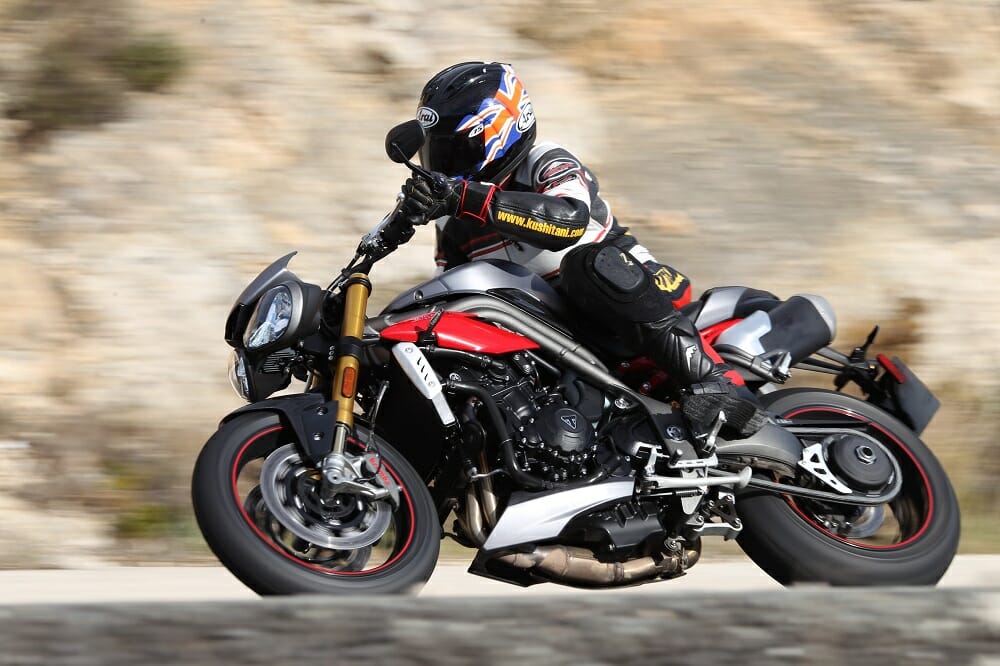 Revamped ergonomics make big days in the saddle much more accommodating.
Revamped ergonomics make big days in the saddle much more accommodating.
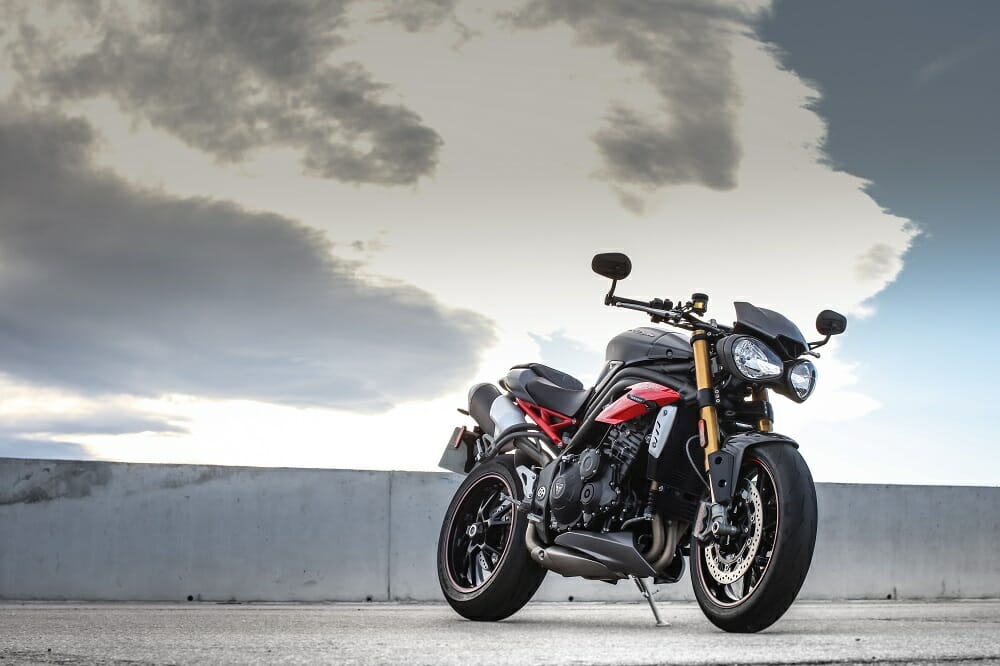
History Lesson
From being a somewhat crude stripped-out sportbike when first concocted by the simple expedient of deleting the bodywork from the Daytona 900, the Triumph Speed Triple metamorphosed into a serious street rod with the introduction two years later in 1996 of the T509, complete with John Mockett’s so-distinctive goggle-eyed styling and a fuel-injected 885cc motor. This was replaced in 1999 by a new-generation 955cc engine producing the same 108 bhp dyno readings, but with much improved torque.
In 2005 Triumph then delivered heaps more power as well as acres more grunt by stroking the engine to produce 79 x 71.4mm dimensions and a claimed 128 bhp from the resultant 1050cc motor, as well as a hefty increase in torque to 74 lb.-ft. Then in 2011 came a major makeover, with the same 1050cc motor now yielding 133 bhp/81.8 lb.-ft., but even more to the point its hyper-distinctive bug-eye headlamps had been replaced by less retro but still distinctive twin pentagonal wolfeye headlights as part of a total restyling package. Less attitude, more 21st century looks? Whatever, the sales numbers in any case kept right on churning, so that by the end of 2015 Triumph had sold no less than 56,929 Speed Triples with the 1050cc motor, and a remarkable 77,800 examples exactly of all versions of the model built since its 1994 debut.
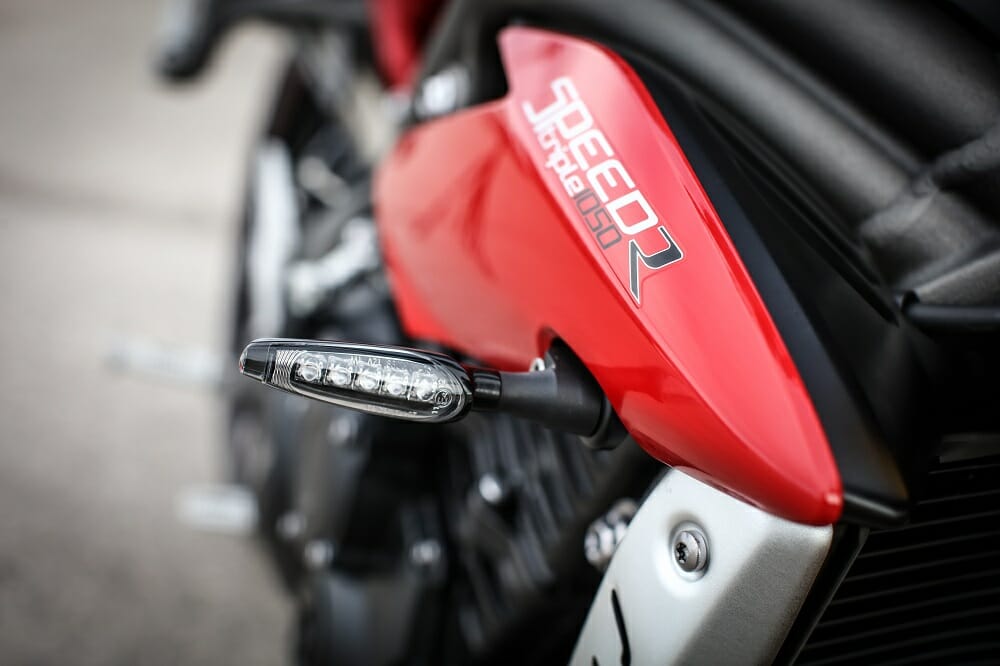 Sleek and stylish, the Speed Triple has lots of detailed touches like these indicators.
Sleek and stylish, the Speed Triple has lots of detailed touches like these indicators.
 The dash is not too dissimilar to the old machine, but just slightly altered in every way.
The dash is not too dissimilar to the old machine, but just slightly altered in every way.
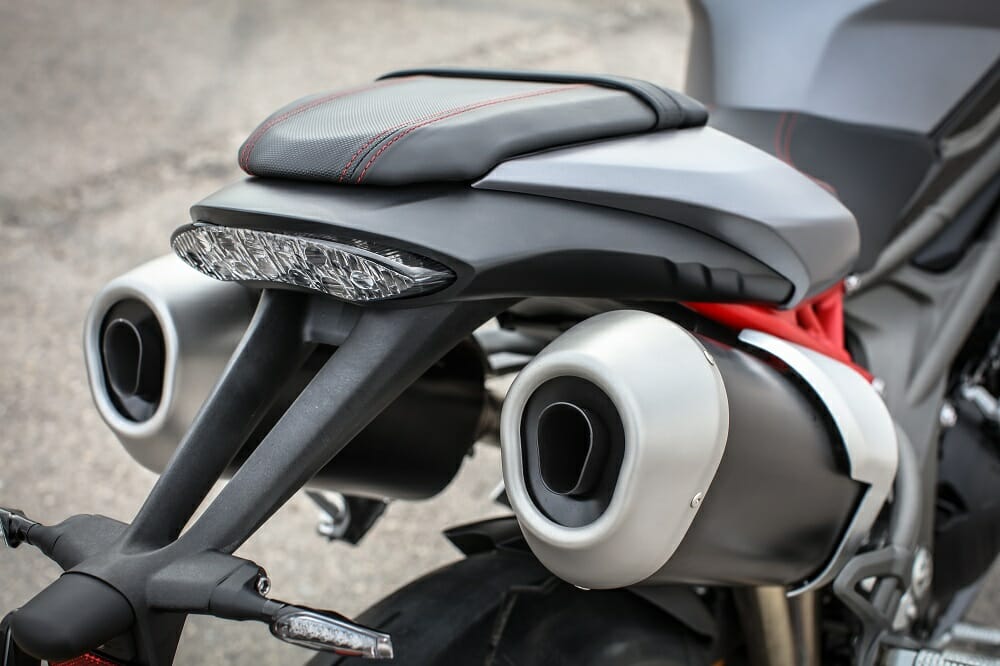
Meeting The Demand
However, that wasn’t the entire rationale for delivering the new model, says Stuart Wood, Triumph’s Chief Engineer.
“Having to meet Euro 4 provided an opportunity for us to make what was already a good bike, and an important model for us, even better,” he says. “We’d already been working on a ride-by-wire throttle package, and we needed to bring that to the bike, but we also wanted to make a big change to the way the Speed Triple looked. A lot of people will see it as an evolution, but I believe it’s more than that. It’s a more elegant bike than the outgoing model, and we put a lot of effort into combining that with the aggressive look that’s been the trademark of the Speed Triple for the past 21 years.
“We wanted to redesign the bike visually, and do the engine as well.”
How cleverly Triumph’s engineering team approached that task can be summed up by one piece of data: in meeting Euro 4 compliance, which has caused many other manufacturers a lot of strife by requiring them to concoct a bulkier, heavier exhaust system to do the job okay, Triumph has ended up with a 3-1-2 stainless steel exhaust that’s actually 10.6 ounces lighter than the old bike’s, as well as simpler, yet, and here’s the best part, it entirely retains the gorgeous three-cylinder howl of the old bike, both when you’re riding it (mainly due to the intake roar) and listening to it ride by. How very satisfying.
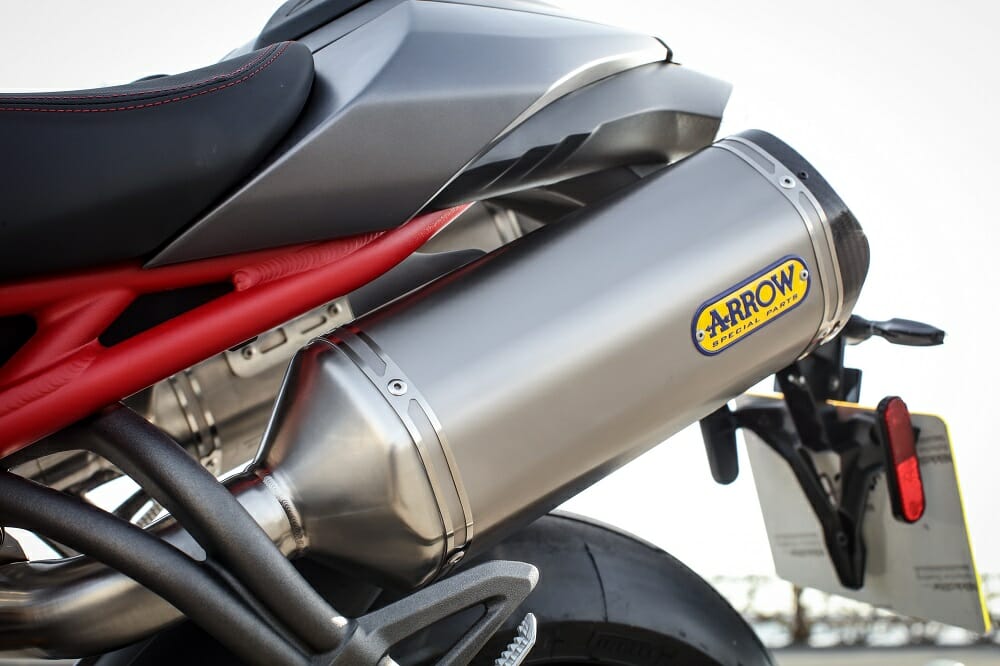 If you’ve got the R, you’ve got to have the pipes!
If you’ve got the R, you’ve got to have the pipes!

All New In The Hood
In completely redesigning the Speed Triple’s satin black-painted 1050cc engine, Wood & Co. have retained the same 79 x 71.4 mm dimensions, but with no less than 104 different component changes, it’s effectively an all-new motor. So while the crankcases are unchanged, the 2016 model’s engine has a new crankshaft, pistons, rings, counterbalancer gears, camshafts, throttle bodies, gearbox ratios, selector mechanism and airbox. There’s also a smaller radiator with a narrower frontal area, a new cylinder head with revised porting and a new combustion chamber design, and a Keihin ECU incorporating an RBW throttle for the first time on this model, with a choice of five different riding modes that are easily selected on the go: Track, Sport, Road, Rain, plus one rider-configurable mode. Each of these offers the full engine performance in terms of peak power and torque, but each delivered differently via a distinctly different throttle response, ABS setting and traction control level. Both the latter are switchable, and each is also included for the first time on the Speed Triple, so that this new 2016 version represents a significant step up in terms of electronic sophistication, and rider assistance, on its predecessor, but not at the cost of a substantial increase in cost.
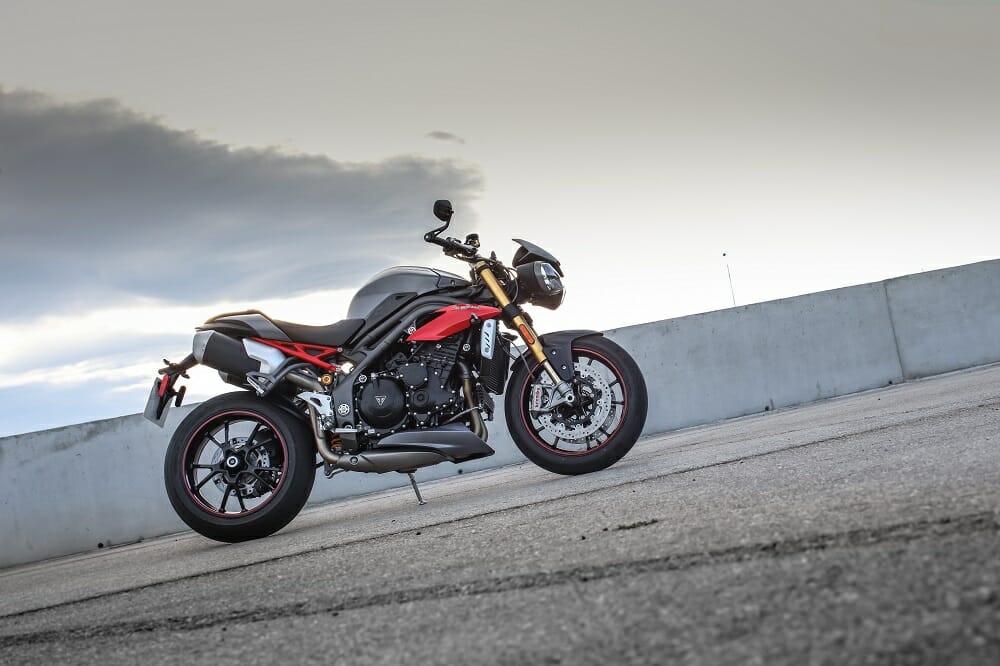
|
SPECIFICATIONS:
|
2016 Triumph Speed Triple
|
|
Engine:
|
DOHC, 4-stroke, 3-cylinder, 12-valve, liquid-cooled
|
|
Displacement:
|
1050cc
|
|
Bore x stroke:
|
79 x 71.4mm
|
|
Horsepower:
|
138 hp @ 9,500 rpm
|
|
Torque:
|
81 lb.-ft. @ 7850 rpm
|
|
Compression ratio:
|
12.25:1
|
|
Transmission:
|
Six-speed
|
|
Chassis:
|
Twin-spar aluminum
|
|
Front suspension:
|
43mm Öhlins NIX30 Fork, fully adjustable
|
|
Rear suspension:
|
Single Öhlins shock absorber, fully adjustable
|
|
Front brake:
|
Twin 320mm discs, Brembo four-piston Monobloc calipers, ABS
|
|
Rear brake:
|
Single 255mm disc, Brembo single-piston caliper, ABS
|
|
Front tire:
|
120/70 ZR17
|
|
Rear tire:
|
190/55 ZR17
|
|
Rake:
|
22.9°
|
|
Trail:
|
3.59 in.
|
|
Wheelbase:
|
56.4 in.
|
|
Seat height:
|
32.4 in.
|
|
Overall height:
|
42.1 in.
|
|
Overall width:
|
30.7 in
|
|
Overall length:
|
81.6 in.
|
|
Fuel capacity:
|
4.09 gal.
|
|
Weight:
|
423 lbs. (dry, claimed)
|
|
Colors:
|
Red/Black
|
You can read the original magazine story by clicking HERE.
For more Cycle News Standard motorcycle reviews, click HERE.
For more Triumph motorcycle reviews, click HERE.